Medieval Moves Review
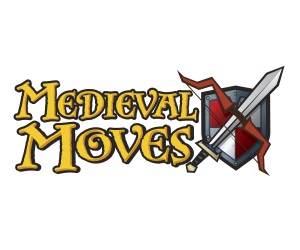 Game: Medieval Moves
Game: Medieval Moves
Developer: Zindagi Games/San Diego Studios
Publisher: Sony Computer Entertainment
Available on: PlayStation 3 only (PlayStation Move required)
Sony have released a follow up of sorts, to their own Move launch title, Sports Champions; this time around, developers Zindagi Games have decided to move on from the well trodden motion controller sports path and instead create an on-rail action adventure; using the Move’s pinpoint-accurate motion controls to hand the player a whole arsenal of weapons to play around with.
STORY: Medieval Moves: Deadmund’s Quest tells the story of young Prince Edmund, heir to the throne. Early on in the game, Edmund’s kingdom is under threat from an evil doer named Morgrimm, who steals a precious amulet. Edmund is turned into a skeleton (now dubbed “Deadmund”) and must retrieve the shards of the amulet, from all manner of bony beings. As you probably guessed from the very first sentence, this is the typical “Boy becomes a hero” tale, filled with all of the generic plot points and events that you would expect. However, as the game does seem to be geared towards the younger crowd, you can’t really fault this functional narrative – even if it is a little samey.
GRAPHICS: While it isn’t going to be wowing the crowds in terms of graphics, Medieval Moves actually looks really good. You have to respect the developers, for trying to make what you would expect to be a dreary game; into one with slightly more colour. Purples, greens, reds and blues litter environments that most developers would paint brown. The design of the characters are nice and chunky looking; certainly building a cartoon-style presentation, perfect for the target audience. The game certainly has it’s own unique, eyecatching look, something many modern games lack.
The game’s (irritatingly long) cutscenes consist of hand-drawn artwork, fitting with the fantasy storybook asthetic that this game has (almost reminiscent of the Fable series, in fact). As good as these static scenes look, it would have been nice for the artwork in the sections to at least resemble the in-game graphics a little more.
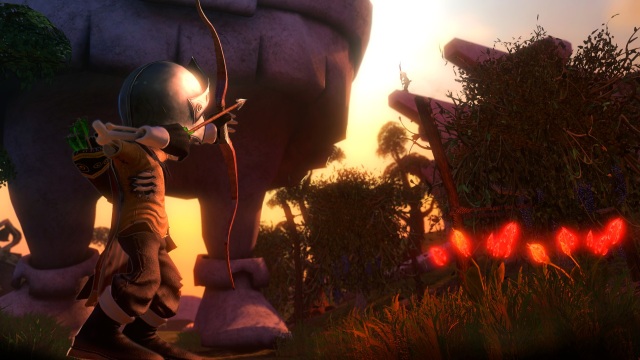
SOUND: Sound is not the game’s strong point. Cutscene dialogue is akin to the kind of voices you’d hear in a Saturday morning cartoon show and luckily there is a option to cut down the amount of in-game speech exclaimed by the hero (much of it annoyingly repeated throughout the game). Sound effects are what you would expect in a game featuring swords, shields, bows and arrows – plenty of clanking, nothing that really stands out. Musically, there is also nothing wrong, but there were some parts of the game that had no music playing at all. Action packed moments when there really should be some suitable backing are relegated to silence, punctuated with the sound of clanking metal.
GAMEPLAY: Medieval Moves is played entirely on-rails. Edmund/Deadmund will traverse various environments by his own volition and every now and then, he will stop and stand his ground as hordes of skeletons attack; this is where the player steps in with an arsenal of motion controlled weaponry, to attack and defend.
At the very start of the game, the player is immediately thrown into a battle with just a sword for protection and it is here you are immediately instructed to swing the sword around, swatting enemies from all directions. It’s also here that you start to immediately hate the sword fighting. Melee attacks involve flailing the Move controller around, and every now and then you might actually hit something. While the Move controller is incredibly accurate; melee combat isn’t; it is tiring, repetitive and not fun at all.
It’s not always clear when you can actually hit an enemy, making for much swearing as you blatantly score a hit, only for it to not register as your target isn’t quite close enough. As great as the idea of swinging a sword around is, in reality it is just not an enjoyable experience, no matter how accurate it is. An early tutorial explains that you can accurately target individual body parts, however, this aspect is something the game never really explores.
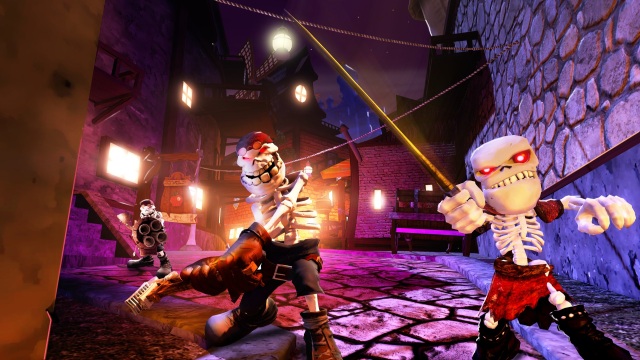
Other weapons suffer from other issues too. For example, you are given the bow and arrow early on in the game and to activate it you pull the trigger, then reach over your shoulder on the same side as the hand you are holding the Move controller in, as if to pick an arrow from a quiver, before pointing the Move controller at your chosen target and letting go of the trigger. The first few times this is performed, it feels like a great method of selecting and using this alternative weapon. Then you actually started playing a real level.
The problem is, reaching over your shoulder is not a movement your body does much and quite frankly, once you’ve done it a few times, it starts to really become uncomfortable. The bow and arrow is way more powerful than melee weaponry, killing many enemies in one hit and because of this you find yourself preferring this weapon, constantly reaching over your shoulder. This is bloody painful and tiring after a short amount of time and is made worse when you miss an approaching enemy with your arrows and have to resort to swinging your sword around.
Another example of the poor motion control design, is when you find some Ninja Stars. “Awesome” I exclaimed to myself as I used a Frisbee-like motion to chuck spiky death at anything that moves. After the short tutorial, showing you how to use this new toy effectively, the level you are in carries on as normal. Instantly, you find that this new weapon is tricky to hit anything with and when you do manage to score a hit you might as well give up and throw balls of cotton wool at enemies, because they’ll probably do more damage.
So you go back to the tried-and-trusted method of using the bow and arrow to dispatch far away fiends, only to find that the game now gets utterly confused at what you are doing and regularly decides that you really would have much more fun throwing Ninja Stars, instead of your intended flurry of arrow fire. When you start getting multiple enemies charging at you, ranged combat now becomes as frustrating as the melee combat.
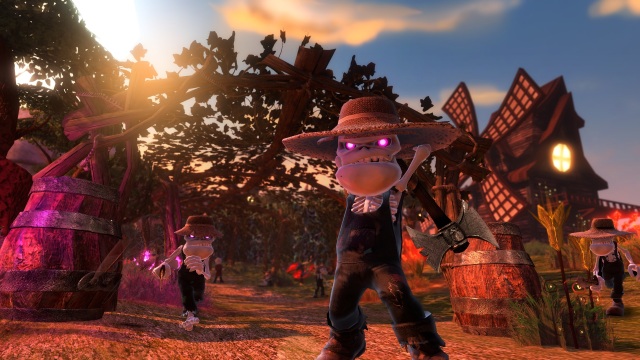
You are left with a multitude of weapons that won’t do what you want, resulting in an army of skeletons, regularly staring you in the face, beating you into a bony pulp. You need to heal and your chosen way to boost your health points is to drink collectable bottles of milk. This is done by (you guessed it) holding a button and mimicking the act of glugging a bottle of milk whole, like some sort of Medieval slob. As you can imagine, when you are being attacked by multiple enemies at once, this is a stressful and frustrating endeavour that almost ends up with you taking more damage than you gain.
MULTIPLAYER: Zindagi Games have added some minigames that can be enjoyed single player or with a friend, online or locally. The modes start with “Invasion”, a simple survival mode where you have to fight your way through as many waves of enemies as possible. Another is “Royal Guard”, where you are required to protect a statue from hordes of attacking enemies. In both modes the player stands in one spot, however using the grappling hook, it is possible to move to other vantage points.
Each multiplayer mode can be customised with a variety of options, from whether a mode’s length is dictacted by the number of enemy waves, or a set length of time – or even what weapons are allowed to be used. There is definitely potential for entertainment within these modes, for multiple players.
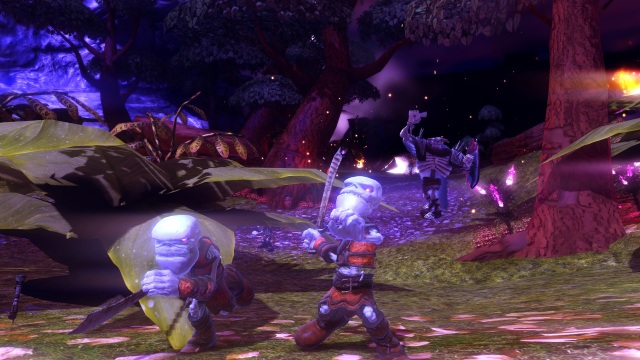
LONGEVITY: If you can get past Medieval Moves’ iffy controls and general repetitiveness, there is a lot of content here. The game’s chapters are quite long (too long as it happens, but luckily they are littered with checkpoints, which the game can be continued from, even after turning the console off), while also filled with collectables and secrets waiting to be found, for the patient and masochistic. The range of multiplayer functions also provide some sort of longevity for those interested in the types of gameplay they offer. Ultimately however, only the dedicated will see everything there is to see in the game.
VERDICT: Medieval Moves combines both the very best examples of motion control, with the very worst implementation of motion control. If this was a collection of minigames framed within a medieval theme, this would have been an entertaining (but unoriginal) title. Instead we’re left with a title that promises much, but is let down by poor execution.
There are some great moments of creativity and imagination here to differ the game from lesser Move titles, but creativity and imagination stand for nothing if doesn’t create a sense of fun and sadly, Medieval Moves is rather dull and repetitive.





